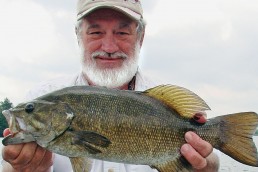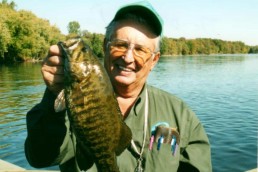The Many Twisting Secrets of the Gasconade
SHARE THIS POST
The Gasconade River is known as one of the most crooked rivers in the world. Less publicized are the towering bluffs, hairpin turns, hundreds of caves and springs and impressive hardwood forests that line this spectacular Missouri river.
You don’t need to dig hard to uncover a fascinating history along the Gasconade either, including stories of Osage Indians, French fur trappers, Civil War raiders, tie hackers, legendary buried gold in the Moccasin Bend area north of Waynesville and even Jesse James.
The Gasconade’s rich past may not be as evident today, but river-goers are still in the know about Gasconade “gold”—the golden trout of the pioneers called brown bass, bronzebacks, redeyes, smallies, or smallmouth bass, which is more commonly used by modern-day anglers.
The angling history of this river is quite fascinating, but never more fascinating than today, with the modern fisheries management programs in place. The Gasconade is home to one of the Missouri Department of Conservation’s 10 Special Bass Management Areas.
“It is the perfect smallmouth river,” said Justin Richardson, of Rolla, and longtime fan of the Gasconade. “You can catch smallmouths far upstream where you can only wade or very near where it runs into the Missouri 300 miles downstream.”
There is 20 miles of specially managed smallmouth area from Riddle Bridge at the end of Highway Y, north of St. Roberts, to the Highway D Bridge at Jerome. However, Richardson prefers to fish above the managed area.
“The managed area has some terrific fishing, but tends to attract more people,” he advised. “I prefer to put in at the Highway 17 Bridge north of Waynesville. It is 15 miles to Riddle Bridge, where the managed area begins, but I spend most of my fishing time in the first 5 or 6 miles below Highway 17. There are lots of big rocks in this stretch. The channels are deep and the current moves right along.”
Richardson still uses a time-tested lure here, the Twin Spin “Nugget.”
“I slow-roll the lure over rocks and logs; I look for this structure in 4 to 6 feet of water. Adding a No. 101 green and white pork frog to the bait makes it a killer.”
He added he rigs his favorite baitcaster with 10-pound P Line, and catches 12- to 14-inch smallmouths.
Nick Miller, of Bourbon, spends a lot of time on the Gasconade and prefers to fish in the SMA region of the river.
“Smallmouth fishing on the Gasconade has improved dramatically since the beginning of the Special Management Area,” he stated.
Are you enjoying this post?
You can be among the first to get the latest info on where to go, what to use and how to use it!
Rule changes instituted over a decade ago have allowed smallmouths to increase in size. Limits on them are now one fish per day, with an 18-inch length limit. The new regulations came into play not long after bass anglers had begun to accept the idea of catch and release.
“I wouldn’t think of killing a smallmouth,” Miller said. “I believe most fishermen on the rivers these days feel the same way. It takes a long time for a smallmouth to grow to 18 inches.”
He added that if handled properly, a smallmouth bass may be caught and released several times by the time it reaches 18 inches and it’s far more favorable than someone taking a smallmouth home to eat.
Miller is quite good at smallmouth fishing and has earned himself a slot on Cowtown USA’s pro fishing staff. He runs one of Cowtown’s Legend SS jet boats while fishing the Gasconade.
“You have to have a good boat to run the river,” Miller said. “All waters are not created equal, and I often run a lot of miles to find the best smallmouth fishing spots. I have fished all of my life and the Legend SS is the best boat I have ever used.”
I tagged along with Miller on a recent fishing trip to the Gasconade. He normally likes to put it at the Jerome access, but recent floods destroyed the MDC access, which is now under repair. Miller spends most of his time between Jerome and Boiling Spring, 8 miles upstream. He took us the long way around and used the area near Highway P just off of 28, south of Dixon, and put in at Boiling Spring.
Within minutes, Miller had the first smallmouth of the day in the boat.
“I like a suspending model that will suspend to 8 feet, but I seldom take it that deep.”
After catching several fish in the vicinity of Boiling Spring, Miller reluctantly headed toward Jerome. He had caught a 5-pound largemouth within 100 yards of Boiling Spring two days prior. He catches a lot of fish near the Jerome Bridge during the cold winter months. He rotated between the bridges and a mile-long stretch of boulder-strewn banks upriver from the bridges. I filmed as Miller steadily put bass in the boat using a Smithwick Rogue and a Storm Wiggle Wart.
Patience is still the key to fishing and Miller exercised his perfectly as he utilized his trolling motor to put the boat in a perfect position to cast to awaiting smallmouth bass.
I had as much fun filming as Miller did fishing. And as we motored back toward Boiling Spring, I couldn’t help but think about the allure of the Gasconade River and the stories and legends that endure. However, it is the real “gold” of the Gasconade, the big brownies—these bronzebacks, these smallmouth bass—that Miller caught which will haunt my dreams.
MWO
SHARE THIS POST
Did you enjoy this post?
You can be among the first to get the latest info on where to go, what to use and how to use it!
Bill Cooper
An inductee to the National Fresh Water Fishing Hall of Fame, Bill Cooper, from the Missouri Ozarks, has written over 4,000 articles on outdoor subjects. You can hear him on Wild at Heart Outdoor radio at espn1073.com.




